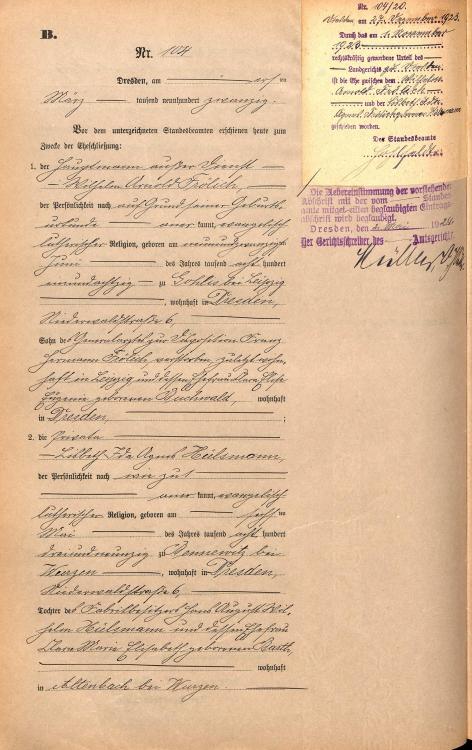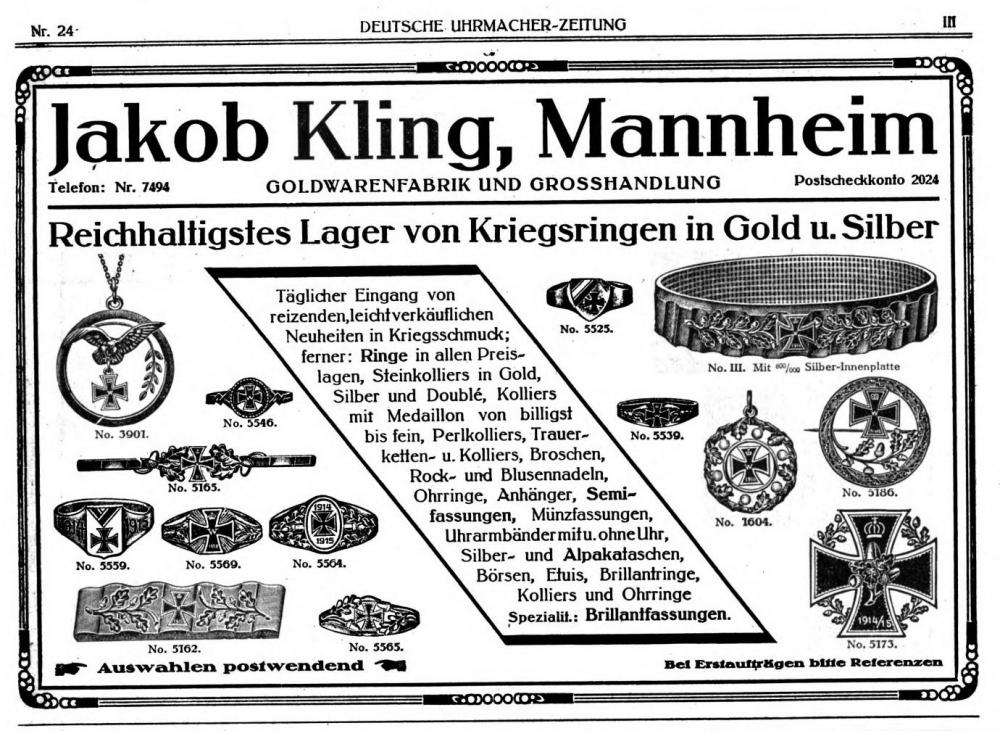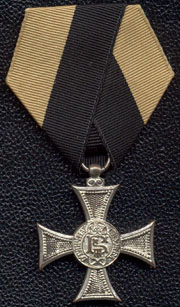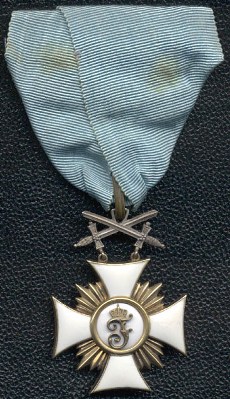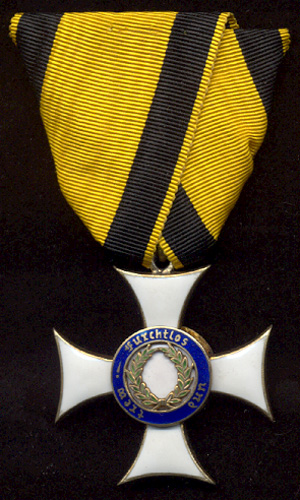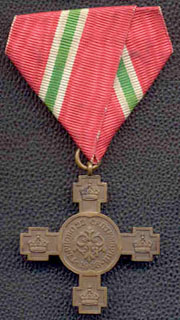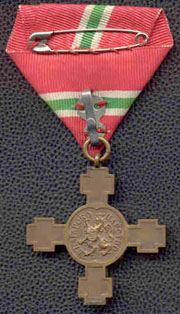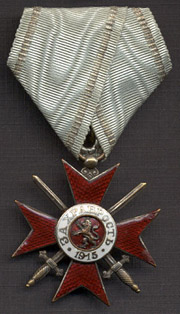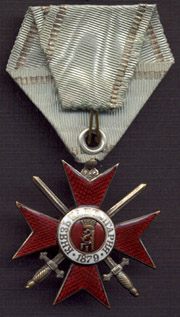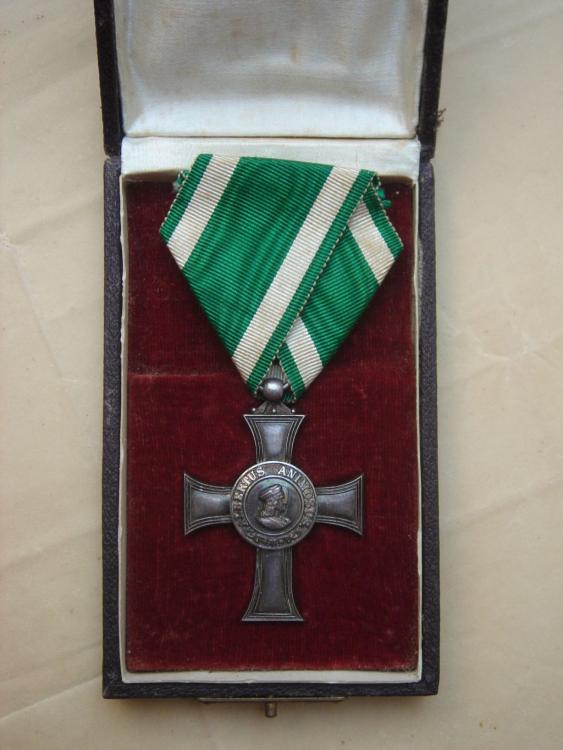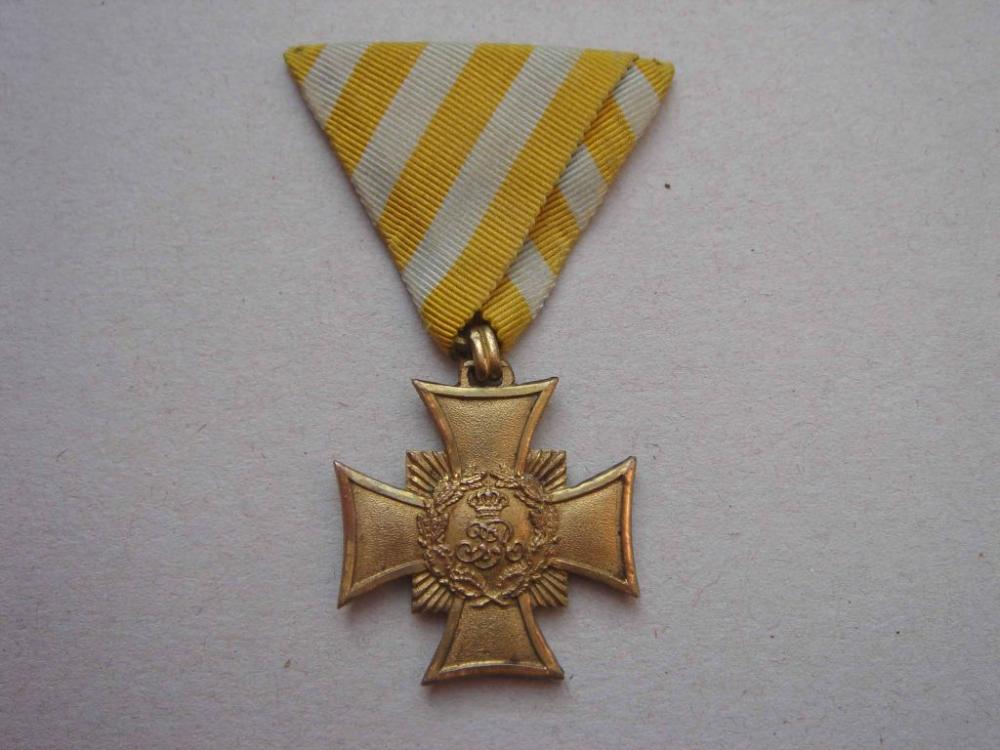-
Posts
4,908 -
Joined
-
Last visited
-
Days Won
97
Content Type
Profiles
Forums
Blogs
Gallery
Events
Store
Everything posted by Dave Danner
-
Bavarian Oberst Friedrich Passavant was attached to the staff of the stellvertrende 4.Infanterie-Brigade from 3.10.1915 to 8.5.1916, when he was named commander of Bavarian Reserve-Infanterie-Regiment Nr. 22. It seems likely your unit was a temporary march regiment of replacement units and troops being transferred to the front.
-
The signature is Oberstleutnant z.D. Wilhelm Lüddecke, *9.12.1861, who commanded Reserve-Jäger-Bataillon Nr. 25 and Reserve-Infanterie-Regiment Nr. 242, and was then a Kreischef in Belgium. He was promoted to Oberst in 1917 and was a char. Generalmajor a.D. And in case anyone didn't notice the rue crown on the stamp, RIR 242 was a Royal Saxon regiment.
-
Just to be clear, and because there were others with the Rufname Gebhard, he was Gebhard Hans Emil, *22.6.1865 in Straußberg, †18.3.1946 in Putbus. He had three brothers: • Karl Hans Gebhard Graf v. der Schulenburg-Wolfsburg, *26.9.1867 in Simnau, †8.9.1950 in Martinsbüttel; Ritter des Ordens pour le Mérite, char. Gen.Lt.a.D. • Hans Gebhard Graf v. der Schulenburg-Wolfsburg, *28.6.1870 in Bremen, †8.11.1946 in Potsdam; Maj.d.L.a.D. • Friedrich Wilhelm Graf v. der Schulenburg-Wolfsburg, *28.3.1873 in Bremen, †14.3.1928 in Potsdam; Oberstlt.a.D.
-
Albert Pichowski was born in Dessau, the capital of the Duchy of Anhalt. Among the basic requirements for the Friedrichkreuz were that one be a citizen of Anhalt and that either you received the Iron Cross or were wounded in action, or both. There were exceptions, of course. The requirements were usually waived for soldiers in predominantly Anhalt units like Infanterie-Regiment Nr. 93, Landwehr-Infanterie-Regiment Nr. 66, and Landsturm-Infanterie-Bataillon Dessau IV/12. Also, officers who commanded a sufficient number of Anhaltiners could be considered. Also, as the war went on, Anhalt made awards to its Landeskinder in units where the Iron Cross was hard to earn, such as Armierungs-Bataillone. There were about 100 awards to officers and men of Reserve-Infanterie-Regiment Nr. 27.
-
Hi Andy and Alf, The May 1918 entries are the Vereins-Lazarett in Heiligenstadt and the Genesungs-Kompanie (convalescent company) of Ers./RIR 27. On page 18, it looks like "nebenstehenden Truppenteil". Despite being born in Dessau and being wounded and decorated with the Iron Cross, he did not receive the Friedrich Cross for some reason.
-

OK, this confuses me.......
Dave Danner replied to Chris Boonzaier's topic in Germany: All Eras: The Iron Cross
-
A few minor corrections. The MVK was the lowest decoration awarded to officers as officers. However, a number of German officers who were commissioned during the war received lower decorations such as the Tapferkeitsmedaille and the Verdienstkreuz. In some cases, these were awarded when they were already officers, but may have been retroactive to when they were enlisted. For example, Leutnant der Reserve Ernst Littmann of the 3.Garde-Regiment zu Fuß received the Eiserne Verdienstkreuz mit der Krone am Bande der Tapferkeitsmedaille on 18.12.1917. Since he had been a Leutnant der Reserve since 18.6.1915 and the Verdienstkreuz was an enlisted award, it seems likely the award was retroactive to when he was an Unteroffizier/Vizefeldwebel in the Gorlice–Tarnów Offensive. Also, at least some Germans did in fact receive the Karl-Truppenkreuz. In most cases, it appears these were Germans attached to Austro-Hungarian units. Lt.d.R. Littmann, in fact, was one of these recipients. His personnel file does not mention an attachment to an A-H formation, but perhaps the regimental history of the 3.GRzF mentions detachments.
-
I am currently preparing the rolls of the Anhalt Friedrichkreuz for publication. I spent a lot of time in the archives in Dessau, where I reviewed the surviving Vorschläge for the awards, which included such information as birthdates and birthplaces, civilian occupations and the like. I can't say for certain if Erich was your great-uncle, but they were born in the same city and both served in the navy as officers, so there is a good chance. Roßlau's population grew from 3.772 in the 1871 census to 5.384 in the 1880 census. Then-Oberleutnant z.S. Irmer served aboard the SMS Hela during the Boxer Rebellion. The Wikipedia article on the Hela states that it arrived after the main fighting, so he probably saw no direct action. Depending on the German state, awards with swords were often made to distinguish wartime from peacetime awards, not necessarily combat awards from non-combat awards.
-
The Albert the Bear was awarded in 1902, so, yes, it was for China. He was born in Roßlau, on the north side of the Elbe facing Dessau (and now part of the combined city of Dessau-Roßlau). He received the Friedrichkreuz on his birthday, 18.03.1917, as a Fregattenkapitän and Dezernent in the Reichsmarineamt. He is one of 11 people with the surname Irmer who received the Friedrichkreuz (4 officers and 7 enlisted men). Several of them were also from Roßlau. One, Hauptmann der Reserve der Marineinfanterie and Schifffahrtsdirektor Erich Irmer (born 29 April 1878 in Roßlau, died 2 December 1936 in Hamburg), might have been his brother. His full name was Louis Hermann Erich Irmer.
-
Having served in both the Bavarian and Prussian Armies is certainly strange, although for those two units it might be less uncommon than for any other Prussian Jäger-Bataillon. Since JB 14 was stationed in Alsace, a Bavarian living there might end up doing his draft time with the batallion and then going back home to Bavaria. I've come across other Bavarians living in Alsace-Lorraine who ended up in local Prussian regiments such as IR 132, although I can't recall any who then transferred to the Bavarian Army. IR 132 and other Straßburg-based regiments were often a stopping place for college students at the university there to do their Einjährig-Freiwilliger year, no matter where in the Empire they originally came from. I still have not been able to put a name to my mystery Bavarian bar, but Daniel and I are of the opinion that while he served in the Bavarian Army in the early 1900s (since he had the 1905 Jubilee), he apparently served in World War I in the Prussian Army, since there are no Bavarian officer matches for his wartime awards (from Prussia, Bavaria, Saxe-Meiningen, Bulgaria and Austria-Hungary).
-
There were at least 46 awards of the Albrechtskreuz mit Schwertern to Prussians, as well as a handful of awards to naval personnel. Most were Feldwebelleutnants. Most of the rest were mid-level Beamten (e.g. Hilfszahlmeister, Feldmagazininspektor, Feldintendantursekretär, Feldhilfsarzt, Feldhilfsveterinär). The swords device does not belong there.
-
I think these Württemberg versions are "sloppy" because they were simply a way of folding the ribbon for presentation, with the expectation that it would later be properly mounted on the recipient's medal bar. Dansson, you EK2 could have been to a Bulgarian as well as to a Saxon. A couple more Bulgarian examples that are even more pentagonal:
-
There were three Bavarian units in the Ostsee-Division. • bayer. Kraftwagen-Maschinengewehr-Kompanie, zugeteilt dem Radfahr-Bataillon Nr. 5 • bayer. Feldlazarett Nr. 23 • bayer. Gebirgs-Artillerie-Abteilung Nr. 2 (bayer. Gebirgs-Kanonen-Batterie Nr. 7, bayer. Gebirgs-Kanonen-Batterie Nr. 12, bayer. Gebirgs-Batterie Nr. 8 (H))
-

King Ferdinand I's decorations
Dave Danner replied to ilieff's topic in Central & Eastern European States
The Iron Cross was not an "Imperial Military order", but a Prussian decoration. He received the Iron Cross 1st and 2nd Classes. From Mecklenburg-Schwerin, he received the Military Merit Cross 1st and 2nd Classes. He probably received the 1st Class of the Oldenburg Friedrich August Cross as well as the 2nd Class, but I don't see it in any of the photos in this thread and the rolls of the cross are not published, so I cannot confirm. From Schaumburg-Lippe, he received the Cross for Loyal Service (Kreuz für Treue Dienste), both on the ribbon and as a pinback cross (Steckkreuz). This is the 10th medal on the medal bar with German decorations in the first post. Boris and Kyrill both received the version on the ribbon. All three awards were on 28.4.1916. The 15th medal on the medal bar with German decorations is the General Honor Decoration "For Bravery" (Allgemeines Ehrenzeichen "Für Tapferkeit") from the Grand Duchy of Hesse (Hessen-Darmstadt). -
Alexander, the July Monarchy (Monarchie de Juillet) was the period from 1830 to 1848 when France was a constitutional monarchy. Given the age, and the tendency of the enamel on this order to break easily, the example you show is in very good shape. You can see some examples of different versions here: http://www.cndp.fr/crdp-reims/ressources/dossiers/legiondhonneur/panneau8ter/panneau8ter.htm


